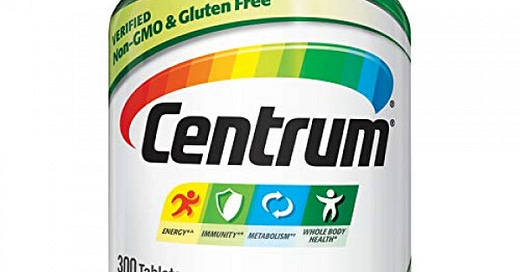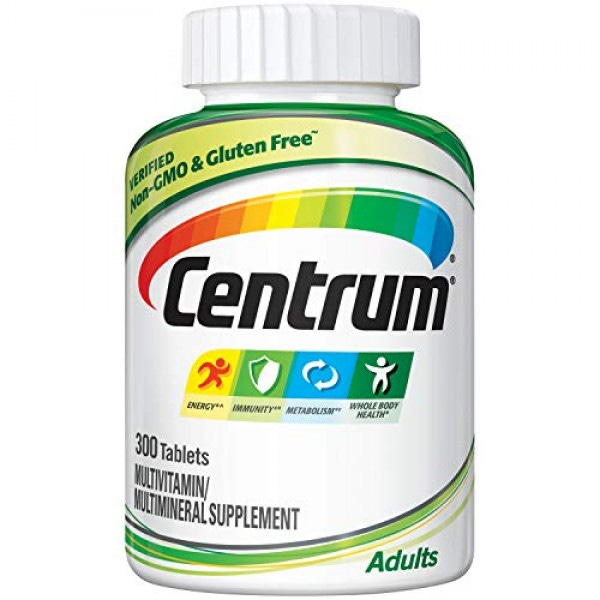What's Wrong with Synthetic Multivitamins?
“The automobile equivalent of creating a multivitamin would be going to a junk yard, finding all of the separate parts you would need to make up an entire automobile, throwing them together in a heap and expecting that heap to drive like a car.”
-Dr. Goran Nikolic and Dr. Dragana Markovic
Vital nutrients important to optimal health such as Vitamin A and iron are not consumed in sufficient amounts by many Americans according to the Dietary Guidelines Advisory Committee to the U.S. Department of Health and Human Services and U.S. Department of Agriculture. Compounding the challenge to most Americans is that many do not always get their vitamins and minerals from whole foods but instead from multivitamins made from chemical synthetic materials.
When mentioning multivitamins in this blogpost, we are referring to multivitamin/multimineral supplements as they are the most commonly consumed supplements among Americans; nearly 1 out of 3 Americans take a multivitamin.
Vitamins and minerals are essential nutrients that perform hundreds of roles for the body catalyzing key processes such as healing wounds, strengthening the immune system, and converting food into energy. Without vitamins and minerals, the survival of various species, including humans, are sub-optimal. Found in both plants and animal foods, each vitamin plays a specific function. For thousands of years, humans survived on natural vitamins from natural animal and plant whole food sources. Night blindness caused by Vitamin A deficiency was treated by ancient Greek and Egyptian physicians through animal liver consumption.
A key element of this historic natural vitamin consumption is that ancient civilizations used whole animals and foods as their vitamin and mineral sources. Such whole food consumption for vitamins and minerals is all too often not the case today. However, vitamins from real foods are more bioavailable and better absorbed by the body than synthetics.
In Dr. Robert Thiel’s medical journal article, “Natural Vitamins May Be Superior to Synthetic,” it was noted that for all of the most common and essential Vitamins - A, B1, B2, B3, B5, B7[1], B9, B12, C, D, E, and K - an animal study found the natural food forms of these vitamins were more greatly absorbed in the blood than the synthetic isolate versions. For example, B12 from natural foods, was absorbed 2.56 times more into the blood than the synthetic B12, cyanocobalamin, often found in energy drinks, which is made through a fermentation process with the addition of cyanide.
Synthetic multivitamins are derived from isolates, unlike in nature, and can come from the most surprising sources. They are chemical synthetics made from fossil fuels such as coal and petroleum derivatives, as well as ground rocks particularly for minerals, among others.
Why are most multivitamins on the market developed this way? Because they can be produced very cheaply. However, in nature, vitamins and minerals are never found isolated. Vitamins and minerals found in a salmon filet or an avocado will have the natural composition including important enzymes and cofactors to allow for better bioavailability, use of a vitamin or mineral by the body.
“It’s unclear how well synthetic nutrients are absorbed and used in the body. Some may be more easily absorbed, not others. This is because when you eat real food, you’re not consuming single nutrients, but rather a whole range of vitamins, minerals, co-factors and enzymes that allow for optimal use by the body. Without these additional compounds, synthetic nutrients are unlikely to be used by the body in the same way as their natural counterparts.”
-Dr. Mary Jane McCluggage, Registered Dietician, and writer for healthline.com
In nature, nutrients are also never found with perfect ratios of 100% of one’s recommended daily values (RDV). That doesn’t exist in foods found whole in nature, as they will be varied. For people practicing the keto or carnivore diet, RDVs are also questionable. Carnivore diets in particular are noted for the elimination of vegetables, which contain antinutrients such as oxalates and lectins that can lower absorption of key minerals like iron and calcium.
RDVs can also vary across government health agencies. For example, the UK National Health Service set an RDV of 700mg for calcium for adults, whereas the U.S. National Institute of Health recommends 1000mg – 42% more.
Prominent health educator, Dr. Eric Berg, of Dr. Eric Berg DC, specializing in the ketogenic diet and intermittent fasting for weight loss, noted in the video below that people sometimes avoid vitamins from real foods because of the lower nutrient dosages. However, these nutrients are more potent and functional because they are not synthetic.
Synthetic vitamins can also be harmful to the body, not merely mal-absorbed. Dr. Paul Saladino, an expert on the carnivore and animal-based diet, doesn’t trust most multivitamins and suspects that some nanoparticles found in them, such as the additive titanium dioxide used for coloring pills white, could be contributing to inflammatory bowel disease in people. Formerly made by Pfizer, titanium dioxide is in GlaxoSmithKline’s popular Centrum® multivitamin. Titanium dioxide is also found in paint and sunscreen products.
In the short term, supplementation from synthetic multivitamins can be beneficial. For example, folic acid supplementation during pregnancy helps reduce neural tube defects. However, in the long-term, folic acid may cause health problems, including cardiovascular disease, cancer, dementia, and Alzheimer’s disease. One study found that folic acid supplementation, in place of naturally occurring Vitamin B9 (folate), increased the probability of being diagnosed of prostate cancer.
“These findings highlight the potential complex role of folate in prostate cancer and the possibly different effects of folic acid-containing supplements vs. natural sources of folate."
-Excerpt from “Folic acid and risk of prostate cancer: results from a randomized clinical trial (2009)”
Similarly, the benefits of multivitamins are mixed. Two trials done in men only suggest there is some borderline-significant evidence that multivitamins can reduce one’s chances of cancer, with no effect on cardiovascular disease. However, from those studies, the U.S. Preventive Services Task Force – an independent panel of experts in primary care and prevention appointment by the U.S. Government Agency for Healthcare Research and Quality – indicated that there is limited evidence to recommend using multivitamins to prevent cancer and cardiovascular disease. One women’s study found that multivitamins increase mortality by 2%.
An article in Nutrition Journal, Addressing Nutritional Gaps with Multivitamin and Mineral Supplements, concluded that multivitamin benefits outweigh any risks associated with taking them. However, the article is highly suspect to a conflict of interest as the author, Ms. Elizabeth Ward, received an honorarium from Pfizer for the development of this article. Further, editorial support for the article was funded by Pfizer.
How does one spot synthetic vitamins and minerals? By taking a close look at the label on your bottle and reading the ingredients, it is pretty quick to spot if your supplement contains synthetic or real vitamins and minerals.
Food Matters wrote an excellent article that laid out five steps to spot synthetic vs. real vitamins and minerals. In summary:
Try to spot the words “100%” natural on the product label.
Find the food source on the ingredients listing. If no real foods are listed, it’s synthetic.
Identify whole foods in the ingredient list, instead of a particular vitamin or mineral.
Look for salt form additives in the ingredient list – acetate, bitartrate, chloride, gluconate, hydrochloride, nitrate, succinate, etc. - if they’re there, it’s synthetic.
Locate ingredients that end in “ate” or “ide.” These signify it’s synthetic.
Despite synthetics in multivitamins, all of these nutrients are found readily available in animal foods on a nose-to-tail carnivore diet or a diet based on animal foods. A nose-to-tail diet contains organ meats which are found to be among the most nutrient-rich, bioavailable foods on the planet.
If a multivitamin is like a car built from junkyard parts, organ meats are like sports cars, especially liver, with all of the top-of-the-line parts. This article by Hunter & Gatherer, a UK-based carnivore, paleo, and keto-friendly online store shows the different kinds of organ meats and their nutritional benefits.
Though whole foods are always the preferred form of eating and obtaining nutrients, it can be hard to source organ meats, and they can be time-consuming to prepare. That is why we prefer eating dessicated/freeze-dried, whole food-concentrated organ meats such as bison or beef liver.
“Truly natural dietary supplements are made from freeze-dried real food, or otherwise are not heated, and the nutrients they contain are natural doses without added synthetics.”
-Dr. Phil Maffetone, internationally recognized author, researcher, and clinician
Synthetic multivitamins are comprised of the “junkyard parts” of chemical isolates, while desciccated/freeze-dried or prepared whole foods, particularly liver and organ meats, contain a natural and bioavailable supply of the vitamins and minerals our human bodies’ need – something our ancestors were well in tune with. While advancements in chemical sciences have made synthetic multivitamins seem like an easier, more efficient way to get the vitamins and minerals we need, we have learned that those vitamins and minerals, derived in quite unnatural ways, are often not as well naturally absorbed and may even cause harm to human bodies in some instances. As we see in this case of liver vs. synthetic multivitamins, sometimes, the natural, ancient ways remain the best.
👉If you enjoyed this post, feel free to share it with friends!
Related Articles:
[1] Vitamin B7 (Biotin) was previously known as Vitamin H.
Core Scientific Journal Articles Referenced:
Thiel, Robert. 2001. Natural Vitamins May Be Superior To Synthetic Ones. Medical Hypotheses. 55(6): 461-469.
Rautianien, S, M. Gaziano, W. Christen, V. Bubes, G. Kotler, R. Glynn, J. Manson, J. Buring, and H. Sesso. 2017. Effect of Baseline Nutritional Status on Long-term Multivitamin Use and Cardiovascular Disease Risk. Jama Cardiology. 2(6): 617-625.
Nikolic, Goran and Dragana Markovic. 2015. Misconceptions About Nutritional Supplements And Modern Diseases. Journal of Nutrition and Dietetics. 4(1): 34-47.
Ward, Elizabeth. 2014. Addressing Nutritional Gaps with Multivitamin and Mineral Supplements. Nutrition Journal. 13(72): 1-10.
Blumberg, J., R. Bailey, H. Sesso, and C. Ulrich. 2018. The Evolving Role of Multivitamin/Multimineral Supplement Use Among Adults In The Age of Personalized Nutrition. Nutrients. 10(248): 1-17.







